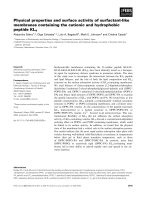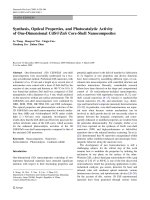Synthesis, physical properties and biradical characters of zethrene based polycylic hydrocarbons 1
Bạn đang xem bản rút gọn của tài liệu. Xem và tải ngay bản đầy đủ của tài liệu tại đây (351.36 KB, 16 trang )
i
SYNTHESIS, PHYSICAL PROPERTIES AND BIRADICAL
CHARACTERS OF ZETHRENE-BASED POLYCYLIC
HYDROCARBONS
SUN ZHE
(B.Sc., Sichuan University)
A THESIS SUBMITTED FOR THE DEGREE OF DOCTOR OF
PHILOSOPHY
DEPARTMENT OF CHEMISTRY
NATIONAL UNIVERSITY OF SINGAPORE
2013
ii
Thesis Declaration
I hereby declare that this thesis is my original work and it has been written by me in its entirety,
under the supervision of A/P Wu Jishan, (in the laboratory Organic & Supramolecular Chemistry),
Chemistry Department, National University of Singapore, between August 2009 and July 2013.
I have duly acknowledged all the sources of information which have been used in the thesis.
This thesis has also not been submitted for any degree in any university previously.
The content of the thesis has been published in:
1) Sun, Z.; Huang, K W.; Wu, J. Org. Lett. 2010, 12, 4690–4693.
2) Sun, Z.; Huang, K W.; Wu, J. J. Am. Chem. Soc. 2011, 133, 11896−11899.
3) Sun, Z.; Wu, J. J. Org. Chem., 2013, 78, 9032–9040.
4) Sun, Z.; Lee, S.; Park, K. H.; Zhu, X.; Zhang, W.; Zheng, B.; Hu, P.; Zeng, Z.; Das, S.; Li, Y.;
Chi, C.; Li, R. W.; Huang, K. W.; Ding, J.;Kim, D.; Wu, J. J. Am. Chem. Soc. 2013,
SUN ZHE
Name
Signature
Date
iii
Acknowledgement
The completion of this thesis depends largely on the efforts and the encouragements of
many people, it would be a great pleasure for me the take this opportunity to express my
sincerest gratitude to them.
Foremost, I wish to give my deepest appreciation to my supervisor, Prof. Wu Jishan, for his
unreserved professional guidance and continuous inspiration. Apart from the academic
guidance, he is also a valuable mentor in my life. I still remembered the words he said to me
when I was frustrated by my first project: “It’s tough to do something new, don’t give up and I
believe you can make it”, and the encouragement he gave when I tried to present my own
ideas: “I like your idea very much, let’s make it happen”. I could not have listed enough of the
inspirations and supports from Prof. Wu, and I could not have imagined having a better
supervisor and mentor for my PhD study. A sincere thanks also goes to Prof. Chi Chunyan for
her enlightening suggestions and kind help over the years during my PhD study.
Next, I am truly grateful to all the past and present members in Prof. Wu and Prof. Chi’s
group, Dr. Zhang Xiaojie, Dr. Yin jun, Dr. Cui Weibin, Dr. Zhao Baomin, Dr. Zhang Kai, Dr.
Luo Jing, Dr. Xiang Hongfa, Dr. Li Yuan, Dr. Zeng Lintao, Dr. Luo jie, Dr. Huang Xiaobo, Dr.
Cao Jing, Dr. Soumyajit Das, Dr. Gao Fei, Dr. Jiao Chongjun, Dr. Li Jinling, Dr. Suvankar
Dasgupta, Dr. Zeng Zebing, Dr. Qu Hemi, Dr. Tong Chenghua, Dr. Shao Jinjun, Mao Lu, Ye
Qun, Ni Yong, Zeng Wangdong, Dai Gaole, Chang Jingjing, Kam Zhiming, Shi Xueliang,
Lim Zhenglong, Hu Pan and Qi Qingbiao. I not only gain precious research experiences
working with them, but also harvest friendships for a lifetime.
Furthermore, I would also thank all our collaborators including Prof. Huang Kuo-Wei, Prof.
Juan Casado, Prof. Ding Jun, Prof. Dongho Kim, Dr. Zhang Wenhua and so on. For without
the efforts of them, the accomplishment of this thesis would not have been possible.
In addition, I would like to thank the National University of Singapore for providing me the
research scholarship. Moreover, I have greatly benefited from many staffs from chemistry
department administrative office, the NMR laboratory and the Mass laboratory.
Last but not least, I would like to thank my loved ones, my parents Sun Gaoyuan and Wei
Hongzhen, and my wife Yang Cong. Their unconditional love and support are the motive
force for me throughout the entire process. I will be grateful forever for their love.
iv
Table of contents
Thesis Declaration ii
Acknowledgement iii
Table of contents iv
Summary vii
List of Tables ix
List of Figures x
List of Schemes xiv
List of Abbreviations xvi
List of Publications xv
Chapter 1: Introduction
1.1 Low band gap polycyclic hydrocarbons with either a closed-shell or an open-shell singlet
biradical ground state 1
1.1.1 PHs with a closed-shell ground state 3
1.1.2 PHs with an open-shell ground state 9
1.2 Overview on zethrene-based PHs 14
1.2.1 Synthesis and reactivity for zethrene-based PHs 15
1.2.2 Applications for zethrene-based PHs 18
1.3 Objectives 20
1.4 References 21
Chapter 2: Zethrene bis(dicarboximide) and its unexpected oxidation
2.1 Introduction 26
2.2 Results and discussion 27
2.2.1 Synthesis and mechanism study 27
2.2.2 Theoretical calculations 31
2.2.3 Photophysical and electrochemical properties 32
2.3 Conclusions 35
2.4 Experimental section 36
v
2.4.1 General experimental methods 36
2.4.2 Characterization data 36
2.5 References 39
Chapter 3: 7,14-Diaryl-substituted zethrene diimides as stable far-red dyes with tunable
photophysical properties
3.1 Introduction 41
3.2 Results and discussion 44
3.2.1 Synthesis 44
3.2.2 Photophysical properties 46
3.2.3 Electrochemical properties 48
3.2.4 Photo-stability test 50
3.3 Conclusions 52
3.4 Experimental section 52
3.4.1 General experimental methods 52
3.4.2 Characterization data 53
3.5 References 58
Chapter 4: Heptazethrene bis(dicarboximide)s with a singlet biradical ground state
4.1 Introduction 61
4.2 Results and discussion 62
4.2.1 Synthesis 62
4.2.2 Variable-temperature
1
H NMR spectra 64
4.2.3 Theoretical calculations 65
4.2.4 Photophysical properties 67
4.2.5 Raman spectroscopic measurements 68
4.2.6 Electrochemical properties 71
4.2.7 Photostability measurements 72
4.3 Conclusions 73
4.4 Experimental section 73
vi
4.4.1 General experimental methods 73
4.4.2 Characterization data 74
4.5 References 79
Chapter 5: Dibenzoheptazethrene isomers with different biradical characters: an
exercise of Clar’s aromatic sextet rule in singlet biradicaloids
5.1 Introduction 81
5.2 Results and discussion 82
5.2.1 Synthesis 82
5.2.2 Variable-temperature
1
H NMR, ESR and SQUID measurements 83
5.2.3 X-ray single crystal analysis and theoretical calculations 86
5.2.4 Photophysical properties 88
5.2.5 Electrochemical properties 93
5.3 Conclusions 96
5.4 Experimental section 96
5.4.1 General experimental methods 96
5.4.2 Characterization data 99
5.5 References 105
Appendix 1 108
Appendix 2 114
Appendix 3 127
Appendix 4 129
vii
Summary
This thesis describes the synthesis, physical properties and potential applications of a series
of zethrene-based molecules, including zethrene bis(dicarboximde)s, heptazethrene
bis(dicarboximide)s and dibenzoheptazethrene derivatives. Due to the presence of both
Kekulé and biradical resonance forms, the ground state of these molecules can be either
closed-shell or open-shell singlet biradical. The moderate biradical character renders
attractive electronic, optical and magnetic properties which allows a diversity of applications.
Chapter 1 firstly presents an overview of recent advances in low band gap polycyclic
hydrocarbons. The ground state of these molecules is either closed-shell or open-shell due to
the structural difference, and they are actively participated in the materials science. In the
second part of this chapter, a review of zethrene-based compounds is given. The theoretical
calculations, synthesis and primary applications of this interesting class of polycyclic
hydrocarbons are discussed.
In chapter 2, the synthesis and properties of a novel zethrene bis(dicarboximde) compound
are presented. This molecule exhibits good stability and solubility compared to parent
zethrene, and represents good candidate for far-red dyes. Moreover, the unexpected oxidation
reaction of this molecule is also discussed.
In chapter 3, the synthesis and properties of a series of 7,14-diaryl-substituted zethrene
diimides are described. This study is an extension of zethrene diimide compounds and the
functionalizations are allowed on both imide sites and bay region because of a novel synthetic
method. The possibilities of these compounds as novel dyes are also discussed.
In chapter 4, the preparation of soluble and stable heptazethrene bis(dicarboximde)s is
presented which is the first isolation of heptazethrene derivatives. The ground state of these
molecules are determined as open-shell singlet biradical, the properties are studied from both
theoretical and experimental perspectives.
In chapter 5, two dibenzoheptazethrene isomers are synthesized following two facile
synthetic sequences. Both compounds are singlet biradical in the ground state, but the
biradical characters are found dependant on the number of Clar’s Sextet rings in the biradical
form. The physical properties are investigated with a combination of theoretical and
experimental methods.
viii
Keywords: polycyclic hydrocarbons, zethrene, biradicaloid, dye, Clar’s sextet rule
ix
List of Tables
Table 2.1 Photophysical and electrochemical properties of compounds 2-3, 2-8
Table 3.1 Photophysical data of ZDI compounds recorded in DCM
Table 3.2 Electrochemical data of ZDI compounds
Table 4.1 Photophysical and electrochemical properties of compounds 2-3 and 4-3
Table 5.1 Photophysical and electrochemical properties of compounds 5-1 and 5-2.
x
List of Figures
Figure 1.1 Examples of low band gap PHs
Figure 1.2 Functionalized high order acenes
Figure 1.3 High order rylenes and their diimide derivatives
Figure 1.4 Structures of N-annulated rylenes
Figure 1.5 Stable bisanthene derivatives
Figure 1.6 Indenofluorene derivatives
Figure 1.7 Teranthene/quanteranthene derivatives with singlet biradical ground states
Figure 1.8 Bis(phenalenyl)s with singlet biradical ground states
Figure 1.9 Bis(phenalenyl)s with different aromatic linkers
Figure 1.10 Indenofluorene with a singlet biradical ground state
Figure 1.11 Resonance structures for zethrene and higher order zethrenes
Figure 1.12 Drain current (IDS) versus gate voltage (VG) with drain voltage(VDS) at -50 V
for the best-performing OTFT of zethrene with the active channel of W = 1 mm and L = 150
Tm as measured in air
Figure 2.1 Structures of zethrene 2-1, 7,14-disubstituted zethrene 2-2 and zethrene
bis(dicarboximide) 2-3
Figure 2.2 (a) MALDI-TOF Mass spectrum of 2-8, (b) FT-IR spectrum of 2-3, (c) FT-IR
spectrum of 2-8
Figure 2.3 Optimized molecular structures and frontier molecular orbital profiles of 2-3 and
2-8. Some bond lengths are indicated by arrows (Å)
Figure 2.4 Normalized UV-vis absorption spectra (5 x 10
-5
M) and fluorescence spectra (5 x
10
-5
M) of 2-3 and 2-8 in chloroform
Figure 2.5 Photostability measurements for 2-3. UV spectra change under irradiation of (a)
UV lamp, (b) white bulb and (c) ambient condition. (d) Change of optical density of 2-3 at the
absorption maximum wavelength with the irradiation time
Figure 2.6 Cyclic voltammograms of compounds 2-3, 2-8 in dichloromethane with 0.1 M
Bu
4
NPF
6
as supporting electrolyte, Ag/AgCl as reference electrode, Au disk as working
electrode, Pt wire as counter electrode, and scan rate at 50 mV/s
Figure 3.1 Structures of zethrenes, perylene diimide (PDI), terrylene diimide (TDI) and
xi
zethrene diimide (ZDI)
Figure 3.2 Structures of ZDI derivatives
Figure 3.3 UV-Vis absorption and fluorescence spectra recorded in DCM solutions: (a)
absorption spectra of 2-3, 3-1–3-3, (b) normalized fluorescence spectra of 2-3, 3-1–3-3, (c)
absorption spectra of 3-4 and 3-5, and (d) normalized fluorescence spectra of 3-4 and 3-5
Figure 3.4 Concentration dependant fluorescence for 3-1 (a), (b); 3-2 (c), (d) and 3-3 (e), (f)
Figure 3.5 Cyclic voltammograms of (a) 3-1, (b) 3-2, (c) 3-3, (d) 3-4 and (e) 3-5 in DCM (for
anodic scan) and THF (for cathodic scan) with 0.1M Bu
4
NPF
6
as supporting electrolyte,
AgCl/Ag as reference electrode, Au disk as working electrode, Pt wire as counter electrode,
and a scan rate of 50 mVs
-1
.
Figure 3.6 Photo-stability test of 2-3 and 3-4 in CHCl
3
upon irradiation with (a) UV lamp
(254 nm, 4W), (b) white light bulb (100 W) and (c) ambient light
Figure 4.1 Resonance structures of zethrene and heptazethrene
Figure 4.2 Molecular structures of higher order zethrenes and imide derivatives
Figure 4.3 Variable-temperature
1
H NMR spectra of 4-3 in CD
2
Cl
2
in aromatic region and
assignment of aromatic protons. The resonance assignment referred to the structure shown in
Figure 4.2
Figure 4.4 (a) HOMO, (b) LUMO and (c) spin densities of 4-3. The calculations are
performed at CAM-B3LYP level of theory. Blue and green surfaces represent α and β spin
densities, respectively
Figure 4.5 Calculated structures for the closed-shell (a), open-shell singlet biradical (b) and
open-shell triplet (c) states of 4-3. All the structures have a C
2
symmetry with a C
2
axis along
the central six-membered ring. The bond lengths are labeled for the central rings in Å
Figure 4.6 (a) Absorption spectra of 2-3 and 4-3 in chloroform, (b) UV-vis-NIR absorption
spectra of 4-3 in DCM at different temperatures
Figure 4.7 Left: Raman spectra of 4-4 with different excitation wavelength, a) 532 nm, b) 633
nm, c) 785 nm and d) 1064 nm. Right: electronic absorption spectra of 4-4 in CH
2
Cl
2
solution
(broken line) and in solid state (solid line)
Figure 4.8 1064 nm FT-Raman spectra in solid state of: a) 4-4, b) 4-1, and c) 4-2
Figure 4.9 Cyclic voltammogram of compound 4-3 in dichloromethane with 0.1 M Bu
4
NPF
6
xii
as supporting electrolyte, Ag/AgCl as reference electrode, Au disk as working electrode, Pt
wire as counter electrode, and scan rate at 50 mV/s. Inset: Differential pulse voltammograms
of 4-3
Figure 4.10 (a) Absorption spectral changes of 4-3 under ambient light irradiation, (b)
absorption spectral changes under white light irradiation (100 W white bulb), (c) change of
optical density of 2-3 and 4-3 as a function of irradiation time
Figure 5.1 Resonance structures of two DBHZ isomers and chemical structures of
heptazethrene, 5-1 and 5-2
Figure 5.2 Variable temperature
1
H NMR spectra (aromatic region) of 5-2 in THF-d
8
and
assignments of aromatic protons, the assignments referred to structure shown in Figure 5.1
(peak labelled as * is from the impurity in THF-d
8
)
Figure 5.3 ESR spectrum of 5-2 in toluene recorded at 298K
Figure 5.4 ΧT-T plot for the solid 5-2. The measured data was plotted as open circles, and the
fitting curve was drawn using the Bleaney-Bowers equation with g = 2.00.
Figure 5.5 (a) ORTEP drawing of 5-1 and 5-2 measured at 123 K. The hydrogen atoms are
omitted for clarity. (b) Mean values of bond lengths and calculated NICS(1) values in the
DBHZ core for 5-1 and 5-2. (c) Calculated (UCAM-B3LYP) spin density distribution of 5-1
and 5-2; the blue and green surfaces represent α and β spin densities, respectively
Figure 5.6 Calculated SOMOs for (a) 5-1 and (b) 5-2. Left: SOMO-α, right: SOMO-β
Figure 5.7 The optimized structure of (a) 5-1 (singlet biradical), (b) 5-2 (singlet biradical),
and calculated bond lengths of (c) 5-1 (singlet biradical), (d) 5-2 (singlet biradical)
Figure 5.8 OPA spectra (solid line and left vertical axis) and TPA spectra (blue symbols and
right vertical axis) of (a) 5-1 and (b) 5-2. TPA spectra are plotted at λ
ex
/2. Insert are the
photographs of the solutions in chloroform
Figure 5.9 Femtosecond transient absorption spectra (left) decay-associated spectra (right) of
5-1 (top) and 5-2 (bottom) recorded in toluene
Figure 5.10 Z-scan curves of (a) 5-1 and (b) 5-2 by photoexcitation in the range from 1200 to
1700 nm.
Figure 5.11 Absorption spectral changes of (a) 5-1 under white light irradiation, (b) 5-1 under
ambient light, (d) 5-2 under white light irradiation, (e) 5-2 under ambient light irradiation, (c)
xiii
optical intensity changes at 687 nm for 5-1 and 804 nm for 5-2 under white light irradiation,
(f) optical intensity changes at 687 nm for 5-1 and 804 nm for 5-2 under ambient light
irradiation
Figure 5.12 CV and DPV curves for (a) 5-1, (b) 5-2
Figure 5.13 (a) Absorption spectra of 5-1 neutral compound, radical cation and dication, (b)
absorption spectra change from neutral to radical cation, (c) absorption spectra change from
radical cation to dication, (d) absorption spectra change by reduction with Zn
Figure 5.14 (a) Absorption spectra of 5-2 neutral compound, radical cation and dication, (b)
absorption spectra change from neutral to radical cation, (c) absorption spectra change from
radical cation to dication, (d) absorption spectra change by reduction with Zn
Figure 5.15 ESR spectra of (a) 5-1 radical cation (b) 5-2 radical cation in CH
2
Cl
2
(10
-3
M)
solution at 298K
xiv
List of Schemes
Scheme 1.1 The first synthesis of zethrene by Clar
Scheme 1.2 Synthesis of zethrenes from trannsannular cyclization
Scheme 1.3 Electrophile-induced transannular cyclization of 1-53
Scheme 1.4 Synthesis of zethrenes from cyclodimerization and reduction of zethrene
Scheme 1.5 New synthetic route to zethrene and its Diels-Alder addition reaction
Scheme 1.6 Synthesis of heptazethrene/octazethrene derivatives
Scheme 2.1 Synthetic route towards 2-3
Scheme 2.2 Unexpected oxidation reaction under bromination conditions
Scheme 2.4 Proposed mechanism for the formation of 2-8
Scheme 3.1 Two synthetic methods of ZDIs
Scheme 3.2 Synthesis of 3-1–3-5. Synthetic conditions: (a) 3,7-dimethyloctan-1-amine or
2-(2-(2-methoxyethoxy)ethoxy)ethanamine, toluene/ethanol, reflux, 3h; (b)
2,6-diisopropylaniline, AcOH, reflux, 24h; (c) phenylacetylene, Pd(PPh
3
)
2
Cl
2
, CuI,
THF/triethylamine, RT, 30 mins; (d) Pd(OAc)
2
, P(2-furyl)
3
, Ag
2
CO
3
, o-xylene, 130
o
C, 18h;
(e) t-butyl-4-ethynylbenzoate, Pd(PPh
3
)
2
Cl
2
, CuI, THF/triethylamine, RT, 30 mins; (f)
trifluoroacetic acid, DCM, RT, 12h
Scheme 4.1 Reagents and conditions: (a) TMSA, 1equiv., PdCl
2
(PPh
3
)
2
/CuI, THF/Et
3
N, rt, (b)
TIPSA, 2equiv., PdCl
2
(PPh
3
)
2
/CuI, THF/Et
3
N, 70
o
C, (c) K
2
CO
3
, MeOH/THF, rt, (d)
p-benzoquinone, PdCl
2
(PPh
3
)
2
/CuI, diisopropylamine, toluene, 60
o
C, (e) TBAF/THF, rt, 30
min; (f) PdCl
2
(PPh
3
)
2
/CuI, toluene, rt, 1 h
Scheme 5.1 Reagents and conditions: (a) 1,4-dimethyl-2,5-di
-(4,4,5,5-tetramethyl[1,3,2]dioxaborolan-2-yl)phenyl, Pd
2
(dba)
3
, DPEPhos, K
2
CO
3
(aq),
toluene/ethanol, reflux; (b) NBS, BPO, CCl
4
, reflux; (c) KOAc, Bu
4
NBr, DMF, 100
o
C; (d)
KOH (aq), THF/ethanol, reflux; (e) PCC, DCM, rt; (f) mesitylmagnesium bromide, THF, rt;
(g) BF
3
·OEt
2
, DCM, rt; (h) DDQ, toluene, rt; (i) i) n-BuLi, THF; ii)
2,5-dibromobenzene-1,4-dicarbaldehyde, THF; (j) (CF
3
CO
2
)O/DMSO, DCM, -78
o
C; (k)
Pd(OAc)
2
, KOAc, TBAB, DMAc, 160
o
C; (l) i) LiCCSi(i-Pr)
3
, THF; ii) SnCl
2
xv
List of Abbreviations
CV cyclic voltammetry
DDQ 2,3-dichloro-5,6-dicyano-1,4-benzoquinone
DFT density functional theory
DMF dimethylformamide
DMSO dimethyl sulfoxide
ESR electron spin resonance
GNR graphene nanoribbon
HOMO highest occupied molecular orbital
LUMO lowest unoccupied molecular orbital
NBS N-bromosuccinimide
NMR nuclear magnetic resonance
NICS nuclear induced chemical shift
NIR near infrared
OFET organic field-effect transistor
OTFT organic thin film transistor
PH polycyclic hydrocarbon
PDI perylene diimide
QDM quinoidimethane
SQUID superconducting quantum interference device
TBAB tetrabutylammonium bromide
TBAF tetrabutylammonium fluoride
TDI terrylene diimide
TFA trifluoroacetic acid
THF tetrahydrofuran
TMS tetramethylsilane
TPA two photon absorption
ZDI zethrene diimide
xvi
List of Publications
1. Sun, Z.; Huang, K W.; Wu, J. Org. Lett. 2010, 12, 4690–4693.
2. Sun, Z.; Huang, K W.; Wu, J. J. Am. Chem. Soc. 2011, 133, 11896−11899.
3. Sun, Z.; Wu, J. J. Org. Chem., 2013, 78, 9032–9040.
4. Sun, Z.; Lee, S.; Park, K. H.; Zhu, X.; Zhang, W.; Zheng, B.; Hu, P.; Zeng, Z.; Das, S.; Li, Y.;
Chi, C.; Li, R. W.; Huang, K. W.; Ding, J.;Kim, D.; Wu, J. J. Am. Chem. Soc. 2013,









